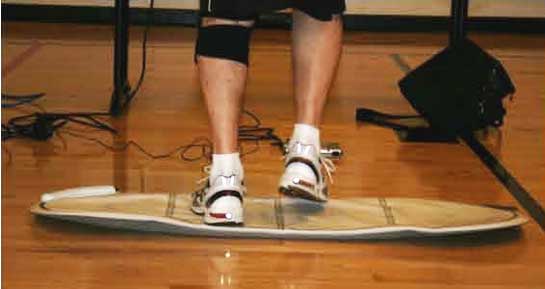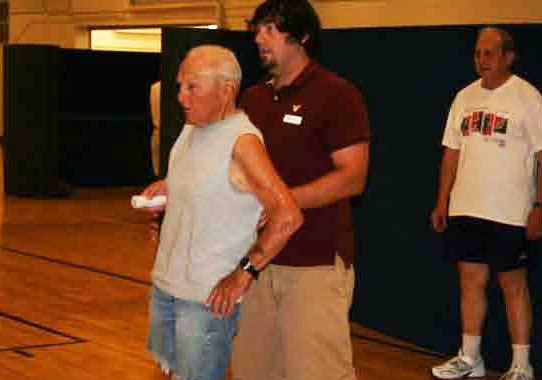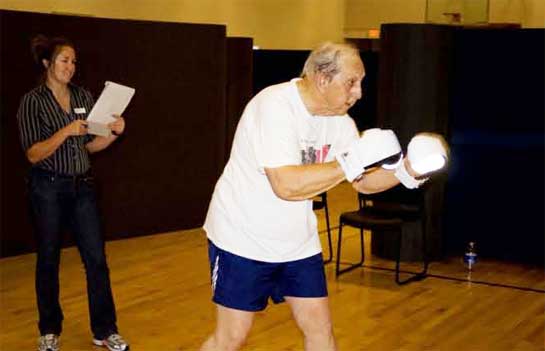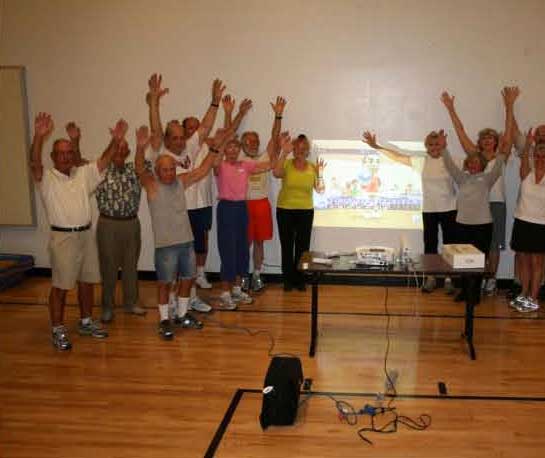
BY SUSAN CAPAROSA, M.A., JEANNE NICHOLS, PH.D., SIMON MARSHALL, PH.D., DANIEL CIPRIANI, P.T., PH.D., TREVOR KINGSBURY, B.S., KENT LORENZ, M.S., KRISTI ROBUSTO, M.S., AND VIRGINIE NICAISE, PH.D.
Introduction
One day a group of 15 adventuresome older adults, ages 67 to 87, gathered in a gymnasium at San Diego State University, which had been transformed into a video-gaming arcade, to engage in exercise using new interactive technology. Alongside the video screens, computers and game consoles, participants could be seen laughing, clapping hands, watching and encouraging each other. Participants tried virtual boxing and bowling with XaviX® equipment, snowboarded or hula hooped on the Wii Fit® balance board, jumped on the XaviX® J-MAT, played Wii® golf and bowling, or stepped to the beat of the music with Dancetown®.
A Comprehensive Approach
Video games that require physical activity (exergames) have the potential to increase physical activity and reduce the time older adults spend being sedentary. This is of great value because older adults are one of the least active groups in society. A diverse group of researchers from the School of Exercise and Nutritional Sciences at San Diego State University designed a sequence of studies to help answer questions about how and why exergames might be used to improve the health and fitness of older adults, and to provide some recommendations to fitness professionals interested in using exergames with older clients. Interestingly, there is a distinct lack of research on the psychosocial, physiological and biomechanical aspects of game play among older adults. Most games are designed for children and adolescents, and almost all previous research has focused solely on measuring the intensity or energy cost associated with game playing in young people. However, older adults have age-related declines in fitness, sensory, cognitive and motor abilities, as well as a lack of technological experiences, which influence exergame play, preferences and safety. New knowledge learned using a comprehensive multi-method approach may help fitness professionals promote safe, effective and enjoyable exergame play in this population.
Study 1: The Exergame Experience for Older Adults
The purpose of the first study was to understand the exergame experience among older adults, identify motivations and game preferences, and describe perceived benefits and barriers to game play. No previous studies had actually invited older adults to sample multiple games across a variety of gaming platforms and then asked them to talk about their experiences. Our research team believed that this was a critical first step because any physiological or biomechanical benefits of participation would be irrelevant if older adults did not enjoy game play.
Fifteen volunteers (9 men and 6 women), ages 67 to 87 years, were recruited from the university’s adult fitness program to participate in a 60-minute “interactive taster session” of seven different exergames (Table 1) followed by a 45-minute focus group. All participants provided written informed consent. Game set-up was standardized to reduce any bias that may result from different-sized screens, playing position or music volume. Participants’ body language and verbal comments were recorded as they played each game, and then again during follow-up focus groups as they talked about their experiences. All recordings were transcribed and analyzed using inductive and deductive thematic analysis to organize what was said into categories.
| Table 1: Description of Exergames Used in Study 1: Interactive Taster Session |
| Game |
Description |
| Wii® Golf |
Players swing a Wii® remote to drive, pitch, and putt a golf ball around a virtual golf course |
| Wii® Bowling |
Players swing a Wii® remote to bowl virtual balls down a virtual bowling lane |
| Wii Fit® Hula Hoop |
Standing on a Wii Fit® balance board, players swivel their hips to twirl and catch virtual hula hoops |
| Wii Fit® Shaun White Snowboarding |
Standing on a Wii Fit® balance board, players distribute their weight to steer a virtual snowboard down the course |
| XaviX® Boxing |
Using boxing gloves with sensors, players throw punches at a virtual opponent |
|
XaviX® J-MAT Dash
|
Players run in place on the J-MAT, trying to accumulate as many steps as possible in 10 seconds
|
|
XaviX® J-Mat Step Lively
|
Players step on the J-MAT in time with bouncing balls to keep them in air
|
|
XaviX® Bowling
|
Players swing a replica bowling ball down a virtual bowling lane
|
|
Dancetown®
|
Players step on a mat using instructional arrows to the beat of the music
|
Results indicate that during game play, older adults focused on seeking strategies to improve (27% of all comments), enjoyment (25%) and perceptions of the challenge (22%). Thus, game experiences were overwhelmingly positive and this appeared related to self-referenced ability and improvement. Games that included tangible strategies to help a player get better (like modeling and prompts) were enjoyed more than games that provided no instructional support. Also, games that helped a player track progress and remember them each time they played (e.g., use of an avatar) were also noted as helpful. The presence of music, competition and realism appeared to increase enjoyment. Games that elicited the most enjoyment were the two bowling games (29% of all bowling comments were about enjoyment), Dancetown (25%), Wii Golf (25%) and XaviX Boxing (25%). Wii Fit Hula Hoop was perceived as the least enjoyable (only 8% of comments or behaviors about Hula Hoop were positive), seemingly because it required too much coordination. Simulation sports, such as bowling and golf, which provide competition, promote skill progression and mastery, were enjoyed the most. Some participants even expressed that they wanted the games to go further and help them learn how to play the real activities. For those who did play the real games, the game version was often a source of frustration. This is an interesting finding because older adults who play the real activities may enjoy the virtual versions the least, in part because the inevitable tendency to compare the two.

Dancetown, a Dance Dance Revolution-like game designed specifically for older adults, was another favorite. The mat was flatter and more solid than the XaviX mat and this made it easier to step cleanly in time to the music. Again, music was the consistent theme for not only enjoying the game, but also evaluating its potential to be considered exercise.
The player-device interface was consistently noted as a critical element of the gaming experience. Participants preferred games that used realistic equipment (e.g., XaviX bowling ball, boxing gloves) and singled out games in which the equipment impeded their play or reduced the game’s feel or authenticity. For example, the XaviX games using the J-MAT (a cushioned mat that records your steps) were criticized for being too distracting. More recently, game companies have tried to improve realism by letting players act more freely in the virtual environments and increasing the sensitivity of the controllers.
Overall, perceived benefits of game play included increased balance, improved motor coordination and new skill development. These factors were identified as motives for future exergame play. Barriers to game play, which potentially undermine motivation for future game involvement, included a perceived lack of cardiovascular benefit, low perceptions of competence, a lack of realism, and poor equipment responsiveness. Combined, the data from this qualitative study suggest that older adults do enjoy playing select exergames, especially sport simulation games and exergames designed specifically for older adults. Incorporating music, strategies for self-referenced improvement or competition, and games that focus on aerobic, strength or balance improvement are likely to be seen as the most beneficial.
Study 2: Physiological Demands of Exergames
Based on the findings from the first study, the same older adults were then invited to participate in a second study to evaluate the relative exercise intensity and energy expenditure of the games they said they enjoyed playing the most. Thirteen individuals (6 male and 7 female, 60 to 85 years), agreed to perform three 5-minute bouts of three exergames that had been identified as enjoyable in the prior “interactive taster session.” Energy expenditure (EE), heart-rate (HR) response and ratings of perceived exertion (RPE) were measured while participants played Wii Bowling, XaviX Boxing and Dancetown (using the same song). Participants rested between bouts until their HR returned to within 10 bpm of their pre-exercise heart rate. During each bout, oxygen consumption (VO2) and HR were assessed continuously and recorded every minute. Minutes 4 and 5 of each bout were averaged for analysis, and RPE was recorded at the end of each game. Results are summarized in Tables 2 and 3.
| Table 2: Physical Characteristics of Participants in Study 2 |
| |
Mean ± SD |
Range |
| Age (y) |
72.9 ± 8.6 |
60 – 85 |
|
Body Mass Index (BMI: kg/m2)
|
25.8 ± 3.4 |
18.3 – 32.8 |
| Estimated Max HR (bpm; 220-age) |
147 ± 9.0 |
135 – 160 |
| Pre-exercise HR (bpm) |
77 ± 8.0 |
62 – 88 |
| Table 3: Study 2: Cardiovascular Responses to Select Exergamess |
| |
Wii® Bowling |
XaviX® Boxing |
Dancetown® |
| VO2 (ml/kg/min) |
5.57 ± 2.20 |
10.89 ± 5.80‡ |
10.37 ± 3.40‡ |
| EE (kcal/min) |
1.50 ± 0.68 |
3.22 ± 2.91‡ |
2.67 ± 1.02‡ |
| METs |
1.59 ± 0.62 |
3.11 ± 1.67 |
2.96 ± 0.98 |
| HR (bpm) |
84 ± 13.0 |
104 ± 13.0‡ |
108 ± 17.0‡ |
| %MHR |
58 ± 9.7 |
70.6 ± 9.6 |
73.1 ± 12.0 |
| RPE (6-20) |
9.4 ±1.3 |
12.7 ±1.78‡ |
13.9 ± 1.8‡ |
| ‡ XaviX® Boxing and Dancetown® were significantly different from Wii® Bowling, p<0.05 |
Results indicate that XaviX Boxing and Dancetown increased VO2, EE, HR and RPE to a greater extent than Wii Bowling. The bowling intensity is considered a light activity (1.6 METs), while boxing (3.1 METs) and Dancetown (3 METs) reached the beginning threshold of moderate intensity (3.0-6.0 METs). Dancetown and XaviX Boxing were equivalent to a 2.5-mph walk on a flat surface and could contribute toward meeting the daily recommendation of at least 30 minutes of moderate-intensity physical activity. Interestingly, during the “interactive taster session” and focus group in Study 1, participants singled out Dancetown and XaviX Boxing as the only games of sufficient intensity to be perceived as "real" exercise. All other games were perceived as too easy or insufficient to derive cardiovascular benefit, an important consideration to this age group. However, most of the participants had above-average cardiovascular fitness because of their regular participation in the university’s adult fitness program. For most older adults, the 3-MET energy requirement of XaviX Boxing and Dancetown would be a sufficient stimulus to induce aerobic adaptations if practiced regularly. Importantly, these games can also be played at more advanced levels to increase the energy demand depending on the player’s level of fitness.

This study supports other research showing that virtual sports participation has a lower metabolic requirement than the real thing. However, for this age group, the benefits of these games far outweigh this limitation. For example, exergaming is an excellent alternative to the real thing, especially for those older adults who can no longer get to a bowling alley or play golf or tennis due to age-related transportation issues and/or mobility and health limitations. In addition, the lower-intensity and lower-skill demands of the games may suit older adults who find regular physical exercise too challenging. The 2008 Physical Activity Guidelines for Americans states that older adults “should be as physically active as their abilities and conditions allow.” Furthermore, even the light-intensity exergames promote activity and burn more calories than sitting; thus, exergames should be used as a fun and engaging substitute for sedentary pursuits such as TV viewing. In summary, results indicate that exergaming has the potential to be a safe and effective tool for maintaining or improving cardiovascular fitness (if the right games and options are selected), as well as reducing sedentary time among older adults.
Study 3: Biomechanical Aspects of Exergames
Study 1 indicated that older adults believe functional fitness is an attractive benefit of exergaming, which is an aspect that appears to have been overlooked in the scientific literature. For example, it is of interest to examine how exergames can be used to develop strength and improve balance, especially in older adults. In Study 1, numerous participants pointed out the real-world benefits, particularly in terms of core strength and balance,

The purpose of Study 3 was to biomechanically quantify exergame play and to evaluate the potential of select games to challenge balance and to promote balance control in 11 older adults (4 males, 7 females), ages 60 to 80 years. The Nintendo Wii® gaming console was used and consisted of three games: Wii Sports Bowling, Wii Fit® Shaun White Snowboarding, and Wii Fit Hula Hoop. The Wii Fit games use the Wii Balance Board accessory. These three games were chosen to target either a walking action (bowling) or a balance activity (snowboarding and hula hoop). A force plate was used to assess ground reaction force (GRF) and user-defined 100% limits of stability (LOS). LOS is a way of measuring the “confidence” an individual has to lean his or her body in different directions. LOS measures how far a person is willing to lean forward, sideways and backward, all while standing. Individuals with very good balance control can lean much farther forward (or backward, or sideways) than individuals with poor balance control. Prior to playing the first game, three baseline measures were obtained: standing weight on the force plate; peak GRF of normal walking; and maximal medial-lateral (side-to-side) and anterior-posterior (forward to backward) displacement (x and y coordinates) from a 100% LOS test. For Wii Bowling, volunteers were instructed to bowl normally and their foot strikes were recorded on the force plate. The peak GFR of the landing foot during bowling was obtained and compared to the peak force for the walking baseline and to the subjects’ bodyweight. For Wii Fit Snowboarding and Hula Hoop, participants were instructed to play the game normally, while five-second intervals of data were recorded for the duration of the activity. All data were expressed as a percentage of the baseline measures and are summarized in Table 4.
| Table 4: Study 3 GRF and LOS Results Summary |
| Game |
GRF and LOS Measurement |
% |
| Wii® Bowling |
% Walking Maximal GRF
% Standing Body Weight
|
98.70%
106.80%
|
|
Wii Fit® Hula Hoop
|
% Anterior-posterior Displacement
% Medial-lateral Displacement
|
113.80%
96.40%
|
| Wii Fit® Shaun White Snowboarding |
% Anterior-posterior Displacement
% Medial-lateral Displacement
|
75.20%
61.40%
|
The three exergames tested in this study (bowling, snowboarding and hula hoop) resulted in GRF and challenges to the LOS that potentially could invoke a lower-limb strengthening (muscle and bone) effect and a balance-control training effect in older adults. The Wii bowling game resulted in maximal GRF that was 98.7% of baseline walking maximal GRF and 106.8% of standing body weight. These results indicate that the bowling game promoted weightbearing and simulated walking forces on the body. Given the importance of walking on the general physical health and well-being of older adults, the Wii bowling game could serve as an additional dose of weightbearing activity similar to walking.
LOS results indicate that certain exergames push an older player past self-imposed limits of stability. Results indicated that the hula hoop and snowboarding games both require the game-player to rotate the body forward and backward, side-to-side, to an extent that approaches and even exceeds the individual’s LOS. Since movement that challenges an individual’s self-imposed LOS can result in improved LOS, the hula hoop game and the snowboarding games could provide balance challenges that improve balance control in older adults. Repetition of this sort of motion may result in improved balance control in the older adult, or an individual with balance-control issues. These findings are encouraging, and provide support for future balance, strength and fall-prevention research using a variety of exergames.

The Bottom Line
Exergaming is not just for kids anymore. The "interactive taster session" demonstrated that older adults enjoy well-designed exergames that provide age-appropriate competition and skill development, facilitate social interaction, and produce fitness and balance improvements. To engage older adults and keep them motivated, fitness professionals should select exergames that are enjoyable and emphasize skill mastery and functional fitness improvements as older adults believe these to be important benefits.
Exergames are a safe, fun and engaging way to get older adults moving—and off the couch. In addition to providing older adults the opportunity to play games and sports that they normally wouldn’t have access to, some exergames provide a cardiovascular stimulus, increase energy expenditure, and offer an enjoyable and rewarding alternative to sedentary activities. For fitness professionals, providing plenty of opportunities for older adults to substitute exergames in place of sedentary behaviors should be a priority. Importantly, all games create opportunities to spend time with friends and family in a fun and physically active way, and fitness professionals are encouraged to offer suggestions of challenges that involve participants’ children and grandchildren.
While exergames provide a broad range of games and activities that could have wide therapeutic use for older adults, our studies demonstrate that not all games are created equal. While some games produce a greater cardiovascular stimulus, others provide superior balance challenges or have better music and realistic graphics. If the goal is to recommend exergames as a way to increase aerobic fitness, then specific levels or types of game play (e.g., dance games and boxing) should be recommended. Exergames such as virtual bowling provide light-intensity fun while promoting weight bearing and simulated walking forces on the body. If the goal is to promote balance and prevent falls then games such as Wii Fit Snowboarding could be used. When making exergame choices that will appeal to this group, fitness professionals should be aware of the physiological and biomechanical demands of each game as well as the social and emotional effects of playing the game.